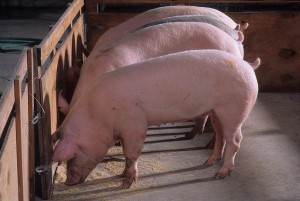Do People and Pigs Share Salmonella Strains?
 If antimicrobial-resistant Salmonella is showing up in pigs, then are bacon-loving people also at risk? In his latest research, NC State population health and pathobiology professor Sid Thakur looks at serotypes, or groups, of antibiotic-resistant Salmonella in people and pigs, to try to determine whether these strains are being passed from pork to people.
If antimicrobial-resistant Salmonella is showing up in pigs, then are bacon-loving people also at risk? In his latest research, NC State population health and pathobiology professor Sid Thakur looks at serotypes, or groups, of antibiotic-resistant Salmonella in people and pigs, to try to determine whether these strains are being passed from pork to people.
Sid Thakur is an expert on antimicrobial resistance in bacteria like Salmonella and Campylobacter, and how they may enter the food supply, particularly via pigs. For his latest study, he wanted to look at whether pigs and humans had the same types of antimicrobial-resistant Salmonella, which is a big public health concern. Thakur compared clinical human samples to samples he took from 30 NorthCarolina farms – from both the pigs and their surrounding environment, including everything from feed to floors – and found seven predominant serotypes of antimicrobial-resistant Salmonella, of which one, Salmonella Typhimurium, is also found in humans.
“Depending on the serotype we’re looking at, we can find similar serotypes in pigs, people and the environment,” Thakur says. “However, the individual genetic ‘fingerprints’ of serotypes can differ. In this case, only Salmonella Typhimurium was the same for people and pigs; however, that doesn’t mean that we can say people are getting this illness from pigs or vice versa.”
Thakur also notes that while the serotypes were the same, the resistance profile – in other words, the drug that the serotype is resistant to – differs from human to pig populations. “In pig populations and their environment, all of the samples we looked at were primarily resistant to tetracycline, which is an antimicrobial commonly used in production environments,” he says. “In humans, the resistance profile was much different.”
So what does this mean for consumers? As always, proper cooking and food handling practices eliminate 99 percent of the problem. And as for the source of the infection itself, “Since the resistance profiles differ, you cannot say that pigs with resistant Salmonella Typhimurium are infecting people,” Thakur says. “Further studies to determine the role played by different reservoirs – people, pigs, and environment – in the food chain will be key to determining which direction the infection is flowing from.”
Thakur’s results appear in Foodborne Pathogen and Disease.
- Categories:


